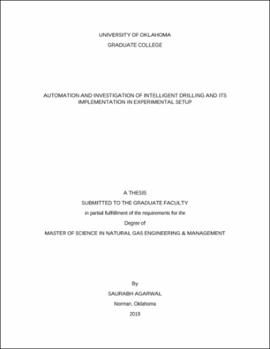| dc.description.abstract | On January 9, 1845, Robet Beart in Great Britain was granted a patent on the first of a new style of rig, the rotary rig with continuous circulation [21]. Since then, not many advancements have been made in drilling technology as compared to other fields such as aviation, communication technology, etc. Drilling rigs are still dangerous to operate, and many rigs operate with unguarded equipment and hazardous operation. Automotive and aeronautical industry recognized this issue for years; thus, they mechanized and automated the operations to make them safer and efficient. The drilling industry is behind the other industries in the implementation of automation; there is a vast scope of automation implementation in this industry. Drilling automation requires hardware such as variable frequency drives (VFD) or alternating current (AC) systems other than software development. Only 25% of the active rigs working on land in the US are AC equipped, according to H&P data.
As the natural gas prices are falling and drilling cost is on the rise, there is a pressure on the drilling industry to do things differently. Automation can reduce the time needed to drill a well by around 25% compared with a driller and the cost of the well by 17% [15]. There is a grouping interest for process automation in the drilling community. Many efforts are made by drilling industries towards automation as an overall objective to achieve efficient drilling. Other benefits of automation are making drilling operation environment safer, allowing remote access, and gather more data.
Through this research, the goal is to advance the automation in the field of drilling to make it safer, cost-efficient, faster and conveniently accessible. In this research past work in the area of drilling, automation has also been examined extensively to contribute further to it. This includes past experimental setups, as well as, the automated drilling setups built in Drillbotics competition by different universities. In this research, best practices from these past setups, and current research practices have been implemented into this research.
This research proposes implementing closed-loop control for automation that continually monitors drilling parameters and drilling performance in real time and constantly adjusts the weight on bit (WOB), rotary speed (RPM), and torque on bit (TORQUE) to maximize the instantaneous rate of penetration (ROP). Precise control of these parameters through closed-loop helps reduce vibration during drilling which significantly improves drilling efficiency [22].
To carry out this research, downscaled experimental setup of a drilling rig has been used. This downscaled model was designed and constructed by Antonio & Teodoriu [6], used in this research to create an intelligent control system for this rig. This experimental setup has all the necessary mechanical components such as top drive, a hoisting system, and more but is missing the necessary brain and sensory system for it to operate autonomously. For example, a human body needs a brain and the six senses to perform any action, similarly, an automatic drilling rig system requires sensors and a program that will automate the action it needs to perform, which is the scope of this research.
Experimental setup requires downscaling of the drilling rig, as downscaling helps mitigate some of the problems such as high inertial forces, large weight, and space requirement. Applying certain methods and using advanced technologies such as six-degree precise vibration generator to replicate bit rock interaction used for re-creating drill conditions becomes easier. The experimental setup provides a safer environment for testing the concept of execution. The closed-loop control system implemented on drilling parameters is thoroughly tested on the setup to analyze the behavior experimental setup and align it with that of a real drilling rig. The downscaling factor used for this setup is 20. Later the results can be upscaled using the same factor to implement in an actual drilling rig.
There is a lot of variability in drilling operation and uncertainty in knowing what is being drilled i.e. the type of formation which is one of the reasons. This intelligent system is using automation and continually monitoring the performance parameters such as weight on bit (WOB) or rotary speed (RPM) and torque help address this uncertainty and achieve a higher rate of penetration (ROP). This facility is unique in the sense that it is automated completely through hardware in the loop and using an intelligent algorithm. This simulation has been developed in LabVIEW.
The goal of this research is to investigate the behavior of an actual drilling rig and replicating the same behavior in the downscaled experimental setup and automating it with focus on the top-drive drilling parameters (WOB, RPM, TORQUE). Automation of these drilling parameters makes drilling safer, faster, cost-effective, and improves ease of operation and gathering data for better decision making. This will be another step in driving the drilling industry towards a technology-oriented approach. | en_US |

